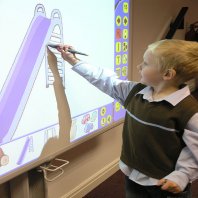The BETT conference is now only two days away. Now I won’t actually be going on day 1 however I do plan to be visiting with some colleagues on Thursday. I haven’t attended the BETT conference in over 8 years having been out of the UK for that period of time although I have attended similar events in the UAE including BETT and BFE, before they were discontinued, and then GESS and GEF following that.
As I prepare to visit BETT I would like to summarize some of my predictions and hopes for the event.
Interactive display technology including the humble Interactive Whiteboard is likely to still occupy a significant number of the vendor stands on display. I am unhappy with this given that IWB technology is now around 25year old however equally I can understand why this might be the case: IWB technology is interactive plus can be demonstrated without any real preparation and where visitors are not required to have any pre-requisite skills, experience or learning. In a class this lack of need for pre-requisite skills is useful at the start of the year when students are new however students don’t remain new for very long.
I expect to see a number of content vendors on show selling interactive content designed for various subjects. Again this is not something I am particularly fond off mainly due to the wealth of free content available on the internet plus the ease with which content can either be created or adjusted by teachers as needed.
I have noticed an increasing number of learning platforms, especially cloud hosted systems, making appearance. I would suspect this trend will continue at BETT.
I expect to see most vendors offering solutions which are incremental improvements on what they previously have offered. I accept that this incremental approach may result in improvements although I question the magnitude of the improvements. I doubt we could consider the improvements to be innovative and it is something innovative I am seeking. I also question whether rather than seeking to be slightly better we should be seeking to do something different, something creative and to bring about disruptive innovation.
My hope is to see some vendors with something truly creative and original. I know of one vendor who will be in attendance who will be demonstrating something which at least partially fits my criteria. They will be demonstrating giant dice like devices which students can sit on but also which students can interact with as part of the lesson, passing and throwing around, answering questions by orientating the dice in various ways. Student interactions with the devices can then be communicated back to a teacher device via Bluetooth allowing for assessment of learning to take place. As such learning becomes both a physical and mental activity while providing teachers with data as to student learning.
I observed another example of what I consider innovative at an event in the UAE. It was a School Management System styled like a social media site with the system making predictions as to what information and users may be useful much in the same way Amazon or similar shopping site predict what other items we may wish to consider buying. The system also made use of a very visual user interface. Sadly since the demo I have been unable to locate this solution so either it never went beyond demo stage or it went out of business at some point. Although the fact it doesn’t exist now is hardly a great selling point, I think the underlying idea had lots of merit and was in a number of ways, innovative.
I hope that BETT will include a number of creative and new solutions for use in learning and that my visit to BETT on Thursday fulfills my expectations! Only time will tell!!











